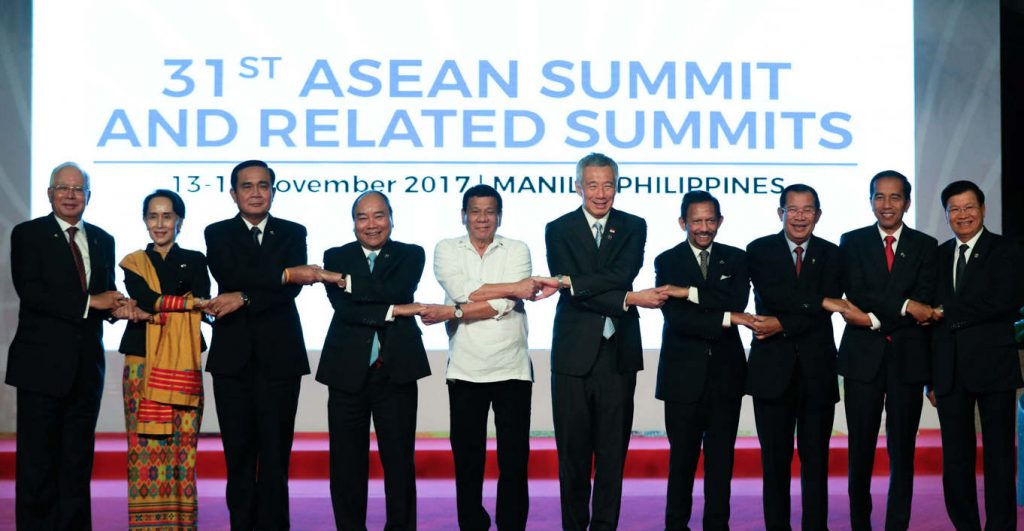On November 13 and 14, 2017, delegates from countries all over the world arrived in the Philippines for the 31st ASEAN Summit. The ASEAN (Association of Southeast Asian Nations) was inaugurated in 1976, and since then has met semiannually to discuss both regional and global initiatives. This year’s theme was “Partnering for Change and Engaging the World”.
[caption id="attachment_3078" align="aligncenter" width="640"]

The 50th anniversary of the founding of Asean. Photo by: asean.org.[/caption]
Currently, the ASEAN Community is made up of ten states who all attended the summit in the Philippines. Other world leaders such as the US President Donald Trump, Canadian Prime Minister Justin Trudeau, and Japanese Prime Minister Shinzo Abe, among others also attended.
While the ASEAN has slowly but surely made progress in the past with its plans (most notably in economic integration and foreign policy), what exactly did the 31st summit accomplish? More importantly, what exactly is in store for the future?
[caption id="attachment_3076" align="aligncenter" width="640"]

Leaders of the 10 ASEAN Countries.[/caption]
Free Trade Agreement
On ASEAN’s economic front, progress has been consistent with the past decades. This time, a free trade agreement was signed between Hong Kong and ASEAN, further reducing trade barriers between the countries.
Hong Kong has been a long-standing trading partner of the Philippines and was ASEAN’s 7th largest trading partner in 2015, but with this step, it is expected that all of the ASEAN countries would make more use of this advantage.
Also important to note is that GDP has constantly increased due to free trade agreements by the ASEAN in the past. The agreement with Hong Kong is expected to have the same impact.
Migrant Workers’ Rights
In 2007, the ASEAN authored a document called the “ASEAN Declaration on the Protection and Promotion of the Rights of Migrant Workers”. It took a decade for the organization to make progress, but this year’s summit has finally yielded a consensus that acts as a follow-up to the issue of migrant rights.
The consensus focuses on equal treatment of migrant workers in terms of placement, safety, and appropriate remunerations. Unfortunately, there are still no legal implications attached to this document. There are also no specific and detailed plans of action. The consensus only serves as a commitment to formulate future plans which we are to expect within the next few years.
It is important to note that the agreed upon consensus does not touch on undocumented workers, which still remains to be a problem in the region.
Code of Conduct with China
Another agreement also made during the ASEAN summit was to start the talks on a COC (Code of Conduct) with China. China has been laying territorial claim over several lands in the South China Sea, despite international law proving that these said lands belong to countries part of the ASEAN.
Once again, the agreement fails to make a large impact due to the lack of legal implications as well as specific plans. President Rodrigo Duterte of the Philippines however has stated that he will work towards a legally-binding COC.
North Korea
The ASEAN’s approach with North Korea however is the complete opposite of their approach with China. The discussion led by Japanese Prime Minister Shinzo Abe focused on one of the top issues raised during the summit – North Korea’s denuclearization.
Abe expressed his concern over the Southeast Asia region being in a state of crisis. This is due to the proximity of the region to North Korea, especially with the recent provocations and constant nuclear missile tests.
The ASEAN and its partners were clear and firm in its condemnation of North Korea. Currently, Japan, South Korea, and now, the ASEAN are united as one against North Korea. Richard Heydarian stated, “If [they] are onboard, then China will also be pressured.”
Despite the several discussions during the ASEAN summit, there was little achieved during the two days. The ASEAN has a habit of discussing goals, with no specific action plans. This can be seen in their many initiatives discussed this summit which yielded no binding implications or consequences for those involved.
What remains to be seen is how the ASEAN follows through with their discussions, and if the organization stays true to its word.
 The 50th anniversary of the founding of Asean. Photo by: asean.org.[/caption]
Currently, the ASEAN Community is made up of ten states who all attended the summit in the Philippines. Other world leaders such as the US President Donald Trump, Canadian Prime Minister Justin Trudeau, and Japanese Prime Minister Shinzo Abe, among others also attended.
While the ASEAN has slowly but surely made progress in the past with its plans (most notably in economic integration and foreign policy), what exactly did the 31st summit accomplish? More importantly, what exactly is in store for the future?
[caption id="attachment_3076" align="aligncenter" width="640"]
The 50th anniversary of the founding of Asean. Photo by: asean.org.[/caption]
Currently, the ASEAN Community is made up of ten states who all attended the summit in the Philippines. Other world leaders such as the US President Donald Trump, Canadian Prime Minister Justin Trudeau, and Japanese Prime Minister Shinzo Abe, among others also attended.
While the ASEAN has slowly but surely made progress in the past with its plans (most notably in economic integration and foreign policy), what exactly did the 31st summit accomplish? More importantly, what exactly is in store for the future?
[caption id="attachment_3076" align="aligncenter" width="640"] Leaders of the 10 ASEAN Countries.[/caption]
Leaders of the 10 ASEAN Countries.[/caption]

